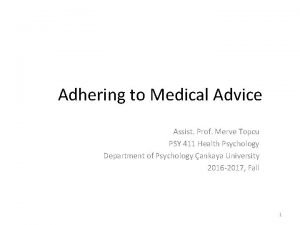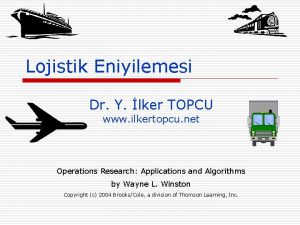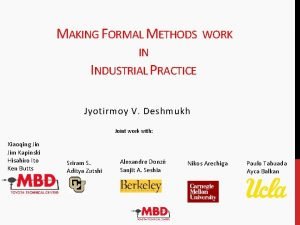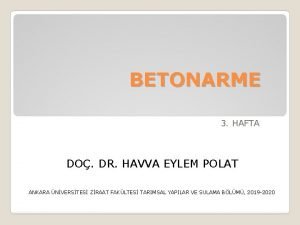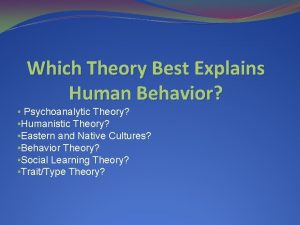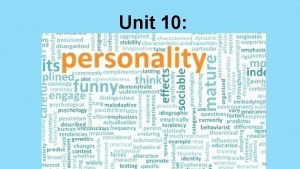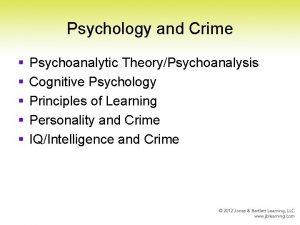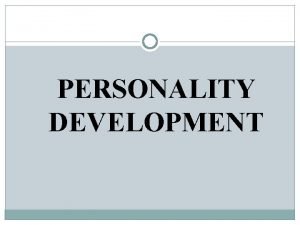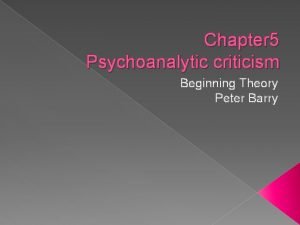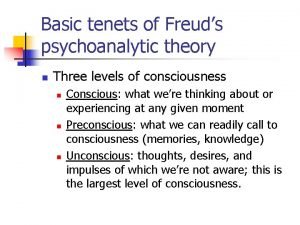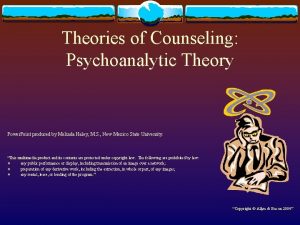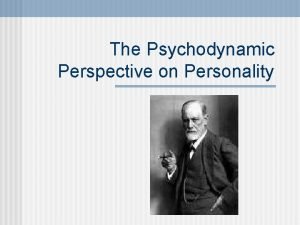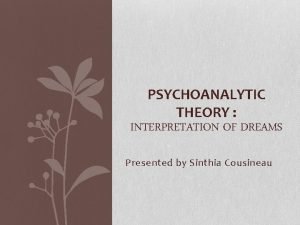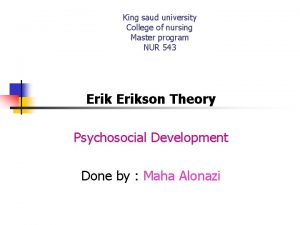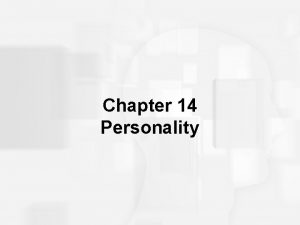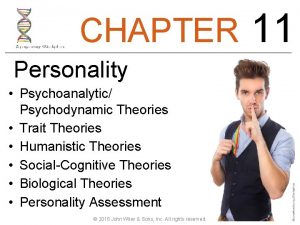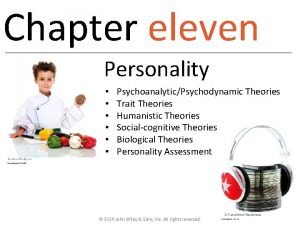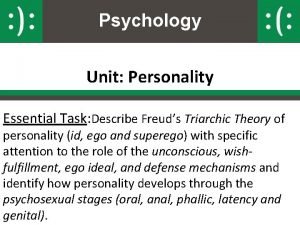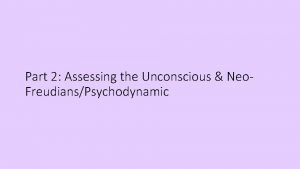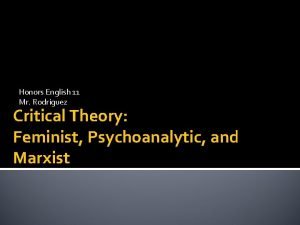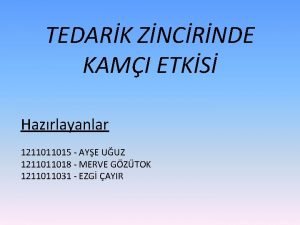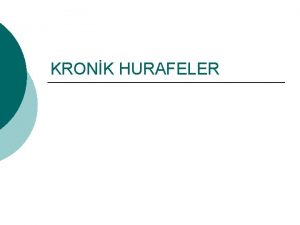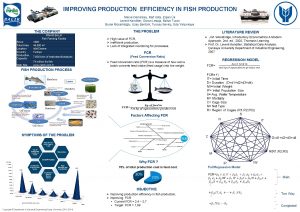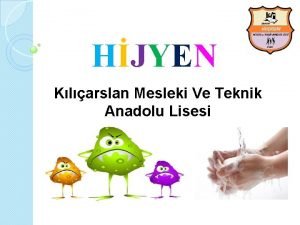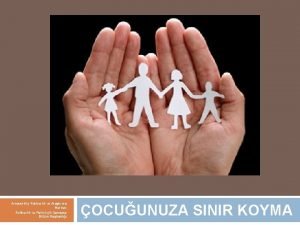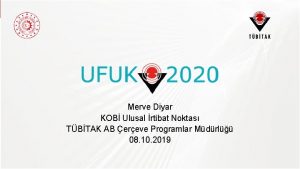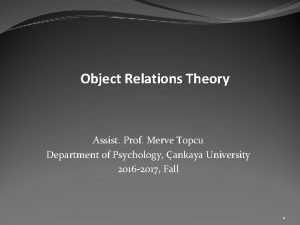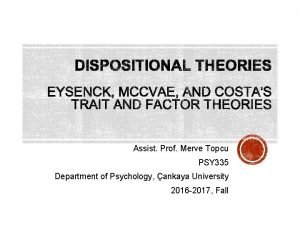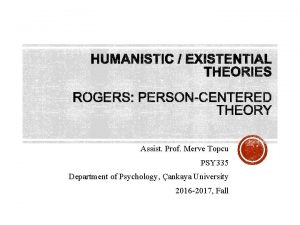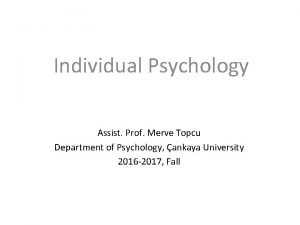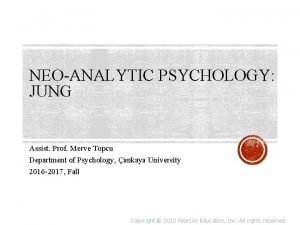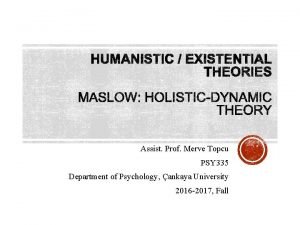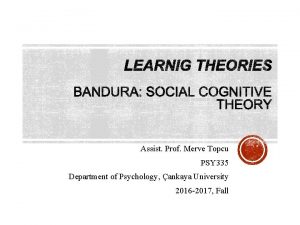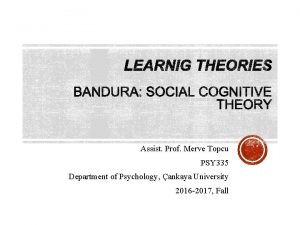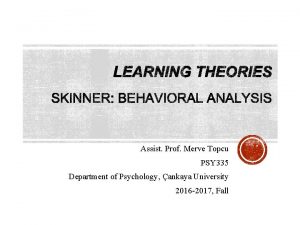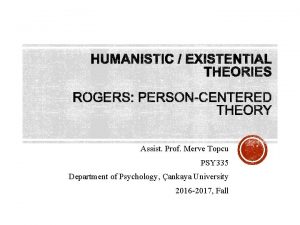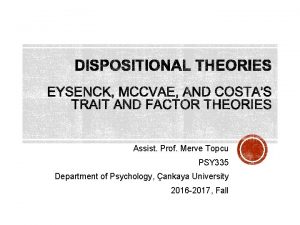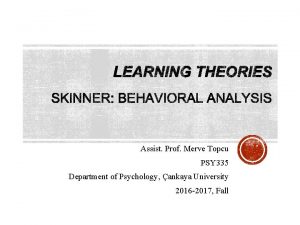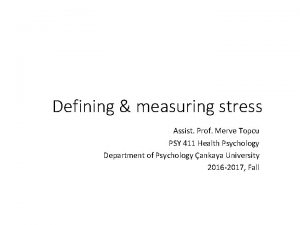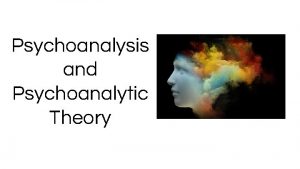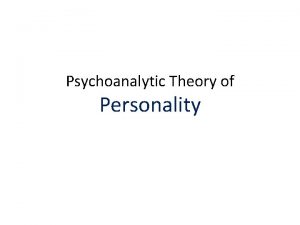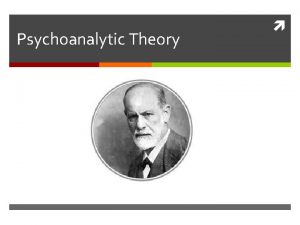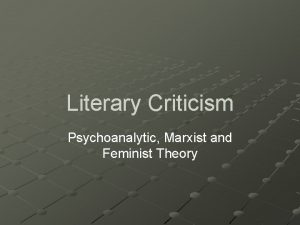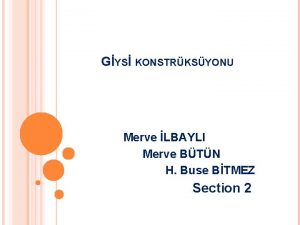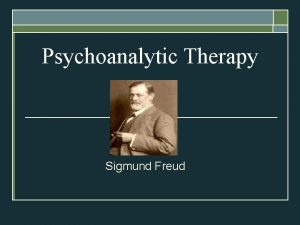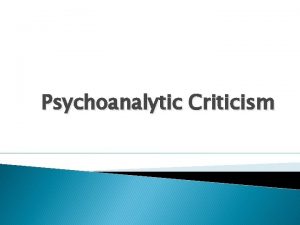Psychoanalytic Theory Assist Prof Merve Topcu Department of































- Slides: 31

Psychoanalytic Theory Assist. Prof. Merve Topcu Department of Psy, Çankaya University 2016 -2017, Fall 1

Content 1. 2. 3. 4. 5. 6. 7. Brief biography Levels of mental health Parts of the mind Psychosexual development Applications of Psychoanalytic Theory Advantages of theory Limitations 2

Psychoanalytic Approach Personality theory based on the writings of Sigmund Freud Emphasizes the unconscious processes of the mind View of free will Behavior is determined by inner drives and conflicts 3

1. Who is Sigmund Freud? Born in 1856 The firstborn child within 8 children Neurologist first, then Psychiatrist Theory is based on observations and experience with patients Over 50 years Deductive reasoning Small sample especially from upper class Not tested under objective conditions 4

1. Who is Sigmund Freud? Hysteria & hypnosis A disorder characterized by paralysis Catharsis Removal of hysterical symptoms by talking Discovery of free association Publication of Studies on Hysteria after Case «Anna O. » with Breur Named approach as Psycho-analysis 5

1. Who is Sigmund Freud? Books Interpretation of dreams On dreams Psychopathology of everyday life Three essays on theory of sexuality Jokes and their relation to the unconscious Psychoanalytic techniques to access the unconscious Hypnosis Free Association Dream Analysis Vienna Psychoanalytic Society (1902) International Psychoanalytic Association (1910) Curl Yung, first president 6

2. Levels of mental life 1. Conscious 2. a. Preconscious 2. b. Unconscious 7

2. Levels of mental life Conscious & unconscious Minor role in psychoanalytic theory Mental elements are directly available to us Sources Perceptual conscious Mental structures 8

2. Levels of mental life Conscious & unconscious The portion of the mind of which a person is not aware Primarily motivates people Includes drives, urges, or instincts Determines our behavior Meaning behind dreams, slips of tongue, certain kinds of forgetting (repression) 9

2. Levels of mental life Dreams, the “royal road” to the unconscious Passage between the unconscious & preconscious Prevents undesirable anxiety-producing memories from awareness Manifest content The content of a dream that a person remembers Latent content The underlying hidden meaning of a dream Repetition compulsion 10

2. Levels of mental life Suppresion & repression Childhood sexual & aggressive behaviors are often punished. Punishment leads suppression of these behaviors Suppression leads anxiety Anxiety leads repression to force unwanted anxiety-ridden experiences into unconscious Defense mechanism against pain of anxiety Phylogenetic endowment Inheritance of our ancestors’ experiences Similar to Jung’s «collective unconscious» 11

2. Levels of mental life Preconscious Material can become easily conscious or with some difficulties Source Conscious perception Unconscious 12

3. Parts of the Mind 13

3. Parts of the Mind 14 Copyright © 2012 Pearson Education, Inc. All rights reserved.

3. Parts of the Mind The Id «The it» Not a part of personality No contact with reality & morality Primitive, chaotic, inaccessible to consciousness, unchangable, illogical, & filled with psychic energy Operates through primary process Strives constantly to reduce tension by satisfying basic needs and seek pleasure Pleasure principle Personification of the Id with demands of ego & restrictions of superego 15

3. Parts of the Mind The Ego «I» Contact w/ reality Grows in infancy Only source of communication with external world Reality principle Tries to show the Id proper ways for satisfaction Personality’s decision-maker Balance btw the Id & the Superego Avoid anxiety Defense mechanisms In order to gain pleasures & avoid pain 16

3. Parts of the Mind The Superego «above-I» Develops at age of 5 -6 with identification of the parents Learn should & should not does Represents moral & ideal self Moralistic & idealistic principles No own energy (similar to the Ego, different from the Id) Desire for perfection so no contact with reality (different from the Ego) 17

Secondary DM Defense mechanisms Primary DM Geri çekilme İnkar (Denial) Tümgüçlü kontrol İdealizasyon vs. değersizleştirme Projection (Yansıtma), Projective identification (Yansıtmalı özdeşim) & Internalization (İçeatma) • Ego bölünmesi • Dissociation (Dissosiasyon) • • • • • • Suppression (Bastırma) Regression (Gerileme) Yalıtma Düşünselleştirme Akılcılaştırma Ahlaksallaştırma Bölmeleme Yapma-bozma Kendine karşı döndürme Displacement (Yer değiştirme) Karşıt tepki oluşturma Reaction formation (Tersine çevirme) Identification (Özdeşim kurma) Eyleme koyma Cinselleştirme Idealization (Yüceltme) Somutlaştırma 18

4. Psychosexual Development Every drive is a source for construction of personality Dynamic theory postulated to explain thedriving forces behind people’s actions The development of the psyche Progresses in stages as the libido (desire, sexual energy) is redirected to different parts of the body Erogenous zones: Body parts capable of producing sexual pleasure 19

4. Psychosexual Development 1. Psychosexual Stages 1. Oral (0 – 18 months) 2. Anal (18 months – 3. 5 years) 3. Phallic (after age of 3) 4. Latency (after age of 6) 5. Genital (after age of 12) 20

4. Psychosexual Development Oral Stage Theme Infants are driven to satisfy the drives of hunger and thirst Conflict Child must give up breast feeding Fixation Dependency & optimism Preoccupation with oral acquisition, hostility & pessimism Thumb sucking as an autoerotic experience 21

4. Psychosexual Development Anal stage Theme: ◦ Child receives pleasure from relieving self of bodily waste Conflict: ◦ Child is “toilet trained” Fixation: ◦ Preoccupation with neatness ◦ Excessive “bathroom humor” ◦ “anal-retentive” & “anal-expulsive” characteristics. 22

4. Psychosexual Development Phallic Stage Theme: Child gains pleasure through the genitals Oedipus Complex-Boys desire mother Castration anxiety Electra Complex-Girls suffer penis envy Conflict: Overt sexual behavior socially unacceptable Fixation: Vanity, narcissism, inability to love 23

4. Psychosexual Development Latency Stage 5 -12 years Theme: Psychosexual energy is channeled into academic and social pursuits Conflicts and fixations do not occur during this stage 24

4. Psychosexual Development Genital Stage (after age of 12) Theme: The individual gains satisfaction from mature sexual relationships This stage is achieved if a person makes it through the other stages with enough available sexual energy no strong fixations “normal” (conventional) adult sexuality is viewed as the healthy outcome Transition to adulthood 25

5. Applications of Psychoanalytic Theory Hyperamnesia “Excess memory” & extract repressed childhood memories The link between the psychoanalytic tool of free association and the more modern notions of signal detection theory Rewards for producing good material No penalty for “false alarms” 26

5. Applications of Psychoanalytic Theory Unconscious Emotions Freudian theory speculates that we can experience internal arousal that we do not cognitively understand Neurological research shows that some emotional events can exist independent of thought 27

5. Applications of Psychoanalytic Theory Infantile Amnesia Freud noted that adults cannot remember much from their early years He attributed this to traumatic conflicts in early life Research has found that all early memories are forgotten, not just traumatic ones Memory is imperfect and subjective memories change over time all memories vary in their “availability” for conscious recall Types of memory Explicit vs. implicit 28 Copyright © 2012 Pearson Education, Inc. All rights reserved.

6. Advantages of theory Emphasizes the importance of childhood Acknowledges the importance of sexual and aggressive drives Attempts to understand unconscious forces Explains defense mechanisms Assumes multiple levels are operating in the brain 29

7. Limitations Pessimistic Focused on pathology Not includes psychoses Long & effortful training Long teraphy sessions Possible to relapse or development of new pathology Difficult to test empirically Sexist (male as norm and model) Modern research has not supported many of its notions 30

Son. . .
 Merve topcu
Merve topcu Ilker topçu
Ilker topçu Ufuk topcu
Ufuk topcu Yaşar kaltakçı
Yaşar kaltakçı Carl rogers theory
Carl rogers theory Psychoanalysis
Psychoanalysis Psychoanalytic theory criminology
Psychoanalytic theory criminology Freud's personality theory
Freud's personality theory Free association psychology definition
Free association psychology definition Example of freud theory
Example of freud theory Freudian literary criticism
Freudian literary criticism Psychoanalytic theory defense mechanisms
Psychoanalytic theory defense mechanisms Basic tenets of psychoanalytic theory
Basic tenets of psychoanalytic theory Sigmund freud psychoanalytic theory
Sigmund freud psychoanalytic theory Introjection example defense mechanism
Introjection example defense mechanism Psychoanalytic theory dreams
Psychoanalytic theory dreams Erikson's psychoanalytic theory of development
Erikson's psychoanalytic theory of development Quiz on freud's psychoanalytic theory
Quiz on freud's psychoanalytic theory 16 source traits
16 source traits Freud psychoanalytic theory
Freud psychoanalytic theory Oedipus complex
Oedipus complex Example of regression defense mechanism
Example of regression defense mechanism Neo freudian theory
Neo freudian theory Psychoanalysis theory
Psychoanalysis theory Merve gözütok
Merve gözütok Merve utku
Merve utku Haccın insan davranışları üzerindeki etkisi
Haccın insan davranışları üzerindeki etkisi Fish
Fish Merve uzunöz
Merve uzunöz Merve başkurt kimdir
Merve başkurt kimdir ödev yapmayınca bahaneler
ödev yapmayınca bahaneler Merve diyar
Merve diyar
